A Freemason Opera?
"The Magic Flute" has often been dubbed "The Freemason Opera" by many music critics and scholars. Indeed, even with my very sketchy knowledge about Freemasons, I was able to recognize many Masonic symbols throughout the opera. The use of the number three is very significant. The opera begins and ends on the same three chords, there are Three Ladies and Three Boys, and three doors to the Sun Temple.
One of the obvious reason for this Masonic influence was that Schikaneder (the librettist) and Mozart were Freemasons. Although the Freemasons would eventually dwindle and almost die out due to their lodges being shut down on suspicions of revolutionary activity, in the eighteenth century Freemasons were plentiful. The finest minds of the age joined the Freemasons. Mozart loved the Freemasons and found many kindred spirits who understood his music and supported him in rough financial times.
After Mozart's death there were wild rumors that the Freemasons killed Mozart for divulging their most prized secrets to the public view in "The Magic Flute". This is ridiculous, however, since the Freemasons supported Mozart's widow and children.
Mozart and Schikaneder, through "The Magic Flute", were actually trying to save the Freemasons by demonstrating to the public that the Freemasons (a.k.a. the Sun Priests) held Reason, Truth and Virtue in the highest esteem. This was a vain effort on Mozart's part since the Hapsburg Monarchy eventually dissolved the Freemasons after Mozart's death.
The Magic Flute is a fairy tale and a philosophy. It is an adventure-rescue story and a political commentary. It is an entertainment and an invitation to enlightenment. It is, simply stated, and endlessly fascinating work of art.
The Magic Flute involves the audience at a conceptual and intellectual level, through the teachings of Sarastro and the trials of Tamino, but also at an emotional level through the love pangs and near suicides of Papageno and Papagena.
The Magic Flute is ecumenical and classless. All those who aspire to the brotherhood are welcome. Deep intellectual and conceptual truths are available to the most common of us if we are prepared to apply our patience, courage, and faith.
The Magic Flute is a work inclusive of all the major musical styles of opera in Mozart's day. Effortlessly Mozart combines the coloratura of opera seria in the Queen of the Night, the simple elegance of opera buffa in Pamina and Tamino, simple German song in Papageno, the spiritual and oracular declamations of Sarastro, and even throws in an old German chorale for good measure.
The Magic Flute has been described by Jeremy Noble as an opera with its head high in the clouds and its feet planted firmly on the earth. A "pop" entertainment which becomes sublime. It was an opera designed to entertain the decidedly unroyal audiences in its first run theater, but it also had a profound moral purpose to improve, to inspire, and to enlighten.
As a member of an audience today, you may treat the opera as a charming and tasty entertainment, just as Papageno accepts his simple pleasures - a good meal, lots to drink, and a loving wife. Neither he nor you will be any the worse for that approach. Or, as you choose, you may find in The Magic Flute the message that things are not as simple as they may seem, that an internal struggle is at work within us, and that rituals, faith, love, the struggle for truth, wisdom, enlightenment, the support of equally committed friends, and overcoming the fear of death, will enable us to prevail in that internal struggle. Visiting Mozart's enlightened world through his work of the Age of Enlightenment, we in the audience today are invited to be free actors able to create our own destinies just as the characters in the opera are able to influence their own lives.
The Magic Flute may itself be thought of as a musical ritual in which the magical effects of music, storytelling, and stage craft link the creative imaginations of all those present in the audience with the world of the sacred or divine. Just as Beethoven's 9th Symphony is a musical journey, or ritual, that invites listeners to join the joyful brotherhood of mankind, The Magic Flute is a musical ritual whose passage by the audience may change them.
Among the many ways in which The Magic Flute can be experienced and has been interpreted are these:
The music
The score contains a wonderful mixture of popular tunes - lied - and opera seria arias, of memorable whistleable or sing-along type songs and the most imposing coloratura challenges. The evening in the opera house delivers a masterful mixture of burlesque and solemnity, of bel canto and opera buffa.
Enlightenment Philosophy
The Magic Flute is sometimes argued to be an allegory for social justice and freedom of belief. The ideas and ideals of the Enlightenment philosophers and hopes of the French Revolution take theatrical form.
Masonic proselytizing
Clearly The Magic Flute is brimming over with symbolism and hidden meanings. The origins of these symbols and meanings are the secret rituals and ceremonies of Freemasonry. Mozart and Schikaneder were members of a Masonic Lodge in Vienna. Thus, the journey that Tamino takes in the opera is thought to be representative of the initiation that a new Mason would have undergone in Vienna in the 1790s.
Although the origins of Freemasonry predate the Age of Enlightenment, the fundamental concepts extolled in both could co-exist comfortably. Truth is to be found in science and reason. Nothing is quite as it seems, and certainly not as simple as it seems on first blush - one must dig deeper to be enlightened. So, in the story, Tamino has to learn through hard work, patience, and the application of reason about the Queen of the Night's true nature, and about Sarastro's.
Fairy tale magic story
The Magic Flute has been taken on one level as a charming fairy tale or magic story. Children (of all ages), in this view, are the best recipients of this charm. To the extent there is something more than adventure in the story, it is the kind of teaching of straightforward morals about truth and integrity that one might find in Grimm. From this point of view, it is completely understandable that someone such as Maurice Sendak should have designed sets and costumes for the show.
Part of the Mozartian Canon of operas
Others take a step back and look at The Magic Flute as but one work among many in Mozart's most well-considered operas. From their point of view, the opera should not be analyzed by itself, but rather in relationship to all the other works, and to all the things that Mozart was trying to tell us through his art. The same kind of analysis is often done with Wagner's 10 canonical operas, and similarly with Verdi's principal operas.
According to this theory, Mozart was always wrestling with certain issues, and he used different operas to present different arguments or points of view with respect to those issues. For instance, the role of women. According to these authors, if one wants to understand how Mozart viewed the role of women, one would be ill-advised to stop with either the fickle and susceptible ladies of CosÁ or the high-minded and faithful Pamina in Flute. One must consider both those shows to see that Mozart was working out his various feelings.
History of the Composition of The Magic Flute
The Magic Flute was written in the last year of Mozart's life. He had been in Vienna for 10 years, but it was a tough town, and Mozart was considered something of a novelty the effect of which had worn off over those years. Younger and newer lights were taking up some of the attention Mozart still deserved. He was teaching and doing commission work to pay the bills, and even that wasn't generating enough income. He often had to beg friends to make loans to him.
Emanuel Schikaneder proposed the Flute idea to him. Schikaneder was five years older than Mozart, and he outlived him by more than 20 years. He had been connected with a traveling theater company for several years appearing in Southern Germany and Austria in comedies, tragedies and singspiele. He was a serious and a comic actor and also wrote plays, with at least 99 works believed to be his, some of which were simply for the spoken theater and some of which were librettos for musical works. As an actor he was particularly famous as Hamlet and King Lear.
In 1789 Schikaneder opened a theater called the Theater auf der Wieden, which specialized in works in the Viennese comic tradition. One of the actors in that theater was Carl Ludwig Giesecke, who, soon after Schikaneder's death, claimed to have been the author of Flute. While he was not likely the sole author, he may well have had some influence on the libretto. (He, too, was a Freemason.)
We don't know exactly when Mozart started composing, but it's clear that he was working on the opera in June 1791. By July 2 Act 1 was finished. Soon he received two famous commissions, which he needed for the money. One was for an opera in honor of the coronation of Leopold II, Austrian emperor, as King of Bohemia, to be performed in early September in Prague. It was to be La Clemenza di Tito. He was also approached by Count Walsegg-Stupach to write a requiem for his recently deceased wife, secretly so that the Count could claim to have written it himself. Tradition has it that Mozart took this commission as a premonition of his own death and that the requiem he was writing was really for himself.
Thus, in the last months of his life Mozart wrote three major works, each of which was in a genre he had not worked in for a long time - opera seria (La Clemenza di Tito); singspiel (Flute); and sacred music (Requiem). Two were commissions. The Flute was his own project.
Mozart finished most of The Magic Flute before beginning work on Clemenza and the Requiem. He still had not finished the overture, the Priests' march that opens Act 2, and possibly three other numbers in Act 2. With that much done, however, Mozart left Vienna in August for Prague where Clemenza was performed on September 6. In mid-September Mozart returned to Vienna and finished Flute on September 28, two days before its premiere on the 30th of September 1791. The opera was not an immediate hit, but over the course of a few weeks it gained in popularity.
Mozart directed the first and second performances. Flute had 20 performances in October and long remained in Schikaneder's repertoire. Mozart saw several performances in October and reported to his wifein a letter that the opera was becoming more and more esteemed. He told her that he was particularly pleased with its growing "silent approval." At one performance he played the glockenspiel while accompanying his friend Schikaneder and intentionally mis-timed the bells as a joke on his friend. He also took his mother-in- law to a performance and his son Karl to another. Salieri, the chief court composer, attended often, always applauding and cheering enthusiastically.
Within 10 weeks after the premiere of Flute, Mozart died on December 5, 1791. Flute remained one of the most popular operas in the German repertory through the end of the century. Goethe thought it a work of high art and even planned a sequel. Its popularity in France and England was not as great. Often it was performed in Italian translation as Il flauto magico. It had a famous revival in 1911 in England, in English, and has remained firmly in the repertoire of all Western nations since.
Freemasonry and The Magic Flute
In understanding Flute it's important to understand something about Freemasonry. Mozart became a Mason in 1784 - Schikaneder and Giesecke were also Freemasons. The Masons of Vienna saw themselves as a philosophical group persecuted by the Hapsburgs and the Catholic Church. Indeed, the Pope had issued two edicts decrying Freemasonry.
Certain elements of The Magic Flute find Egyptian heritage. The gods Isis and Osiris are invoked. Egyptian images and architecture appear. This is a magic land to which Masonry traced some of its origins. Likewise, ancient Persia was viewed as a source of Freemasonry. The character Sarastro's name is certainly derived from the ancient Persian prophet Zoroaster.
Entire books have been written about the Masonic symbolism contained in The Magic Flute. Here are but a handful of examples. The number three held significance in Masonry. Thus, we find three strongly emphasized chords in the overture, three Ladies in the service of the Queen of the Night, three Boys who lead Tamino and Papageno on their quest, in the original cast three slaves and three priests, three temples, three knocks on the doors of the temple, and three flats in the key signature of E flat, the home key of the opera. Other numbers are aslo significant in Masonry. For instance, the 77 strokes of the bastinado which Monostatos is to receive at the end of the First Act hearken to the idea that in Masonry the number 7 represents wisdom. The serpent which chases Tamino, the padlock used to punish Papageno for telling a lie, the portrait of Pamina, the flute and bells, the gender of some of the characters, the references to air, earth, fire, and water, the allusions to darkness and the sun, the colors of certain costumes - all these things can be tied to Masonic iconography.
But the opera was not written for a closed circle of the initiated. It was written for a suburban theater, a popular, not a highbrow theater. One of the amazing things about Flute is that it works on so many different levels, and may either be enjoyed simply for its music and charm, or may be debated and discussed at length as a meaningful treatise on human existence. Or both.
Synopsis
An imaginary Egypt.
Three Ladies attendant on the Queen of the Night save the fainting Prince Tamino from a serpent. When they leave to tell the Queen, the birdcatcher Papageno bounces in and boasts to Tamino that it was he who slew the serpent. The Ladies return to give Tamino a portrait of the Queen's daughter, Pamina, who they say is enslaved by the evil Sarastro, and they padlock Papageno's mouth for lying. The Queen, appearing in a burst of thunder, laments the loss of her daughter; she charges Tamino with Pamina's rescue. The Ladies hand a magic flute to Tamino and magic silver bells to Papageno to ensure their safety, appointing Three Genii to guide them.
Sarastro's Moorish slave Monostatos pursues Pamina but is frightened away by the feather-covered Papageno, who tells Pamina that Tamino loves her and intends to save her.
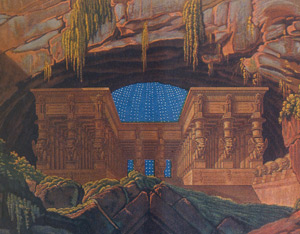
Led to the Temple of Sarastro, Tamino is advised by a High Priest that it is the Queen, not Sarastro, who is evil. Hearing that Pamina is safe, Tamino charms the animals with his flute, then rushes to follow the sound of Papageno's pipes.
Monostatos and his retainers chase Papageno and Pamina but are rendered helpless by Papageno's magic bells. Sarastro, entering in ceremony, promises Pamina eventual freedom and punishes Monostatos. Pamina is enchanted by a glimpse of Tamino, who is led into the temple with Papageno.
Sarastro tells his priests that Tamino will undergo initiation rites. Sworn to silence, Tamino is impervious to the temptations of the Queen's Ladies, who have no trouble derailing the cheerful Papageno from his course of virtue.
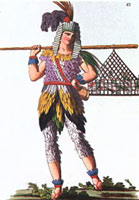
The Queen of the Night dismisses Monostatos, whom she finds kissing the sleeping Pamina, and gives her daughter a dagger with which to murder Sarastro. The weeping Pamina is confronted and consoled by Sarastro.
The gourmand Papageno is just as quick to break a new oath of fasting, and he jokes with a flirtatious old lady, who vanishes when asked her name. Tamino remains steadfast, breaking Pamina's heart: she cannot understand his silence.
The priests inform Tamino that he has only two more trials to complete his initiation. Papageno is eliminated but settles for the old lady, who turns into a young Papagena when the resigned Papageno promises to be faithful. She disappears, however.
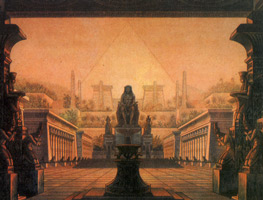
After the Genii save the despairing Pamina from suicide, she finds Tamino and walks with him through the ordeals by water and fire, protected by the magic flute.
Papageno also is saved from attempted suicide by the Genii, who remind him to use his magic bells, which summon Papagena. The two plan for the future and move into a bird's nest.
The Queen of the Night, her Three Ladies and Monostatos attack the temple but are defeated and banished. Sarastro joins Pamina and Tamino as the throng hails Isis and Osiris, the triumph of courage, virtue and wisdom.
|


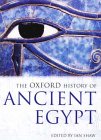

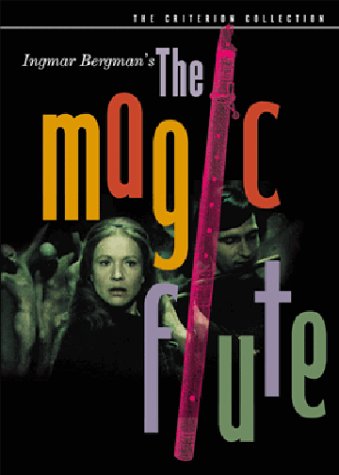

 VIEW MAGIC FLUTE HIGHLIGHTS
VIEW MAGIC FLUTE HIGHLIGHTS



